| |
 |
|
| |
ADC
Air
The Weather-proof
ADC
Ideal for
Manned Aircraft
Note: This product is no longer in
production.
* Overview
*
Ground
Resolution and Field of View
*
System
Controls and Connections
*
Camera
Triggering
*
System
Contents
*
System
Availability
*
Options
*
System
Features and Specifications
*
Additional
Reference Information
*
Image Example
|
|
Click on the
Appropriate Icon Above to View Detailed Notes
on that System.
Scroll down to View Notes on the
ADC Air
|
|
|
|
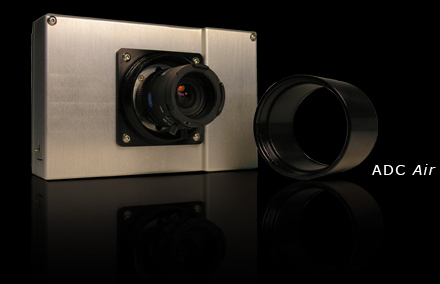 |
| |
Overview
The
ADC Air is a ruggedized single sensor digital multi-spectral camera
designed and optimized for capture of visible light wavelengths longer
than 520nm and near-infrared wavelengths up to 920nm. Like the ADC, the
primary use of this product is for frequencies of light reflected and
absorbed by crop canopies and vegetation. When the ADC Air's output is
fed into the accompanying PixelWrench2 image software, stress factors
and the overall health of the photographed vegetation may be
determined.
Unlike
the ADC, the Air version is weather-tight and fully protected for harsh
environments. All in-flight control is able to be accomplished through
a single cable. Weather sealed doors and a screw-on lens hood allow
full access to camera connectors, lens and CF card when out of the
weather. This is the preferred camera for external mounting on manned
aircraft. The ADC Air is also an ideal solution for long term
vegetation studies in static ground-based installations. |
|
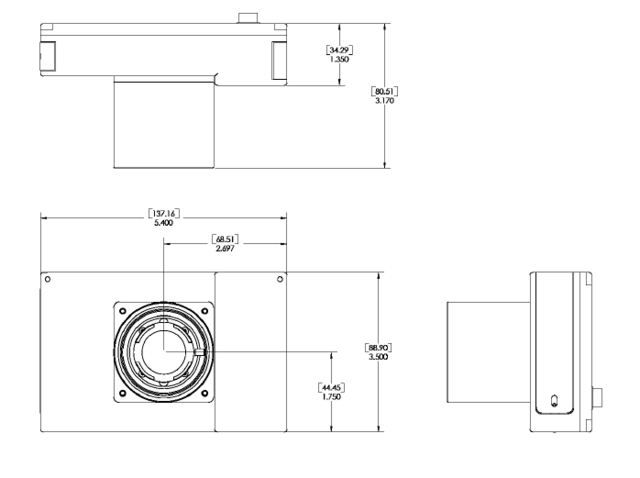
|
|
| |
ADC Air (with 8.0 mm Lens)
Ground Resolution & FOV Examples
The
ADC Air's field of view (FOV) is laid out in a 4:3 format. When
carried in a manned or unmanned aircraft, the field of view increases
as the above ground level (AGL) altitude increases. As the
altitude increases, the camera's ability to resolve individual details
on the ground decreases. With
its standard 8.0 mm lens, when flown at altitude of 400 feet above
ground level, this camera creates an image large enough to capture 1.85
acres at a resolution of less than two inches per pixel in a single
shot! Refer to
our
Multispectral Crop and Application Database or
Selected Readings for descriptions of
example applications.
| Sensor & Lens Parameters |
Object Distance
(Altitude Above Ground Level in meters)
|
Ground Resolution
in mm per pixel |
FOV
(width x height)
in meters |
The
values shown at right were derived from the FOV (Field of View) Optical
Calculator contained in Tetracam's PixelWrench2 software (included with
this camera) using the current values for this camera shown
below:
Sensor Dimensions (mm): 6.55 x 4.92
Pixel Size (microns): 3.2
Camera Lens Focal Length (mm): 8.0 |
122 m (~ 400 ft) |
48.8 |
100 x 75 |
213.4 m (~ 700 ft) |
85.4 |
175 x 131 |
365.8 m (~ 1200 ft) |
146.3 |
300 x 225 |
915 m (~ 3000 ft) |
366 |
749 x 563 |
System Connections and Controls
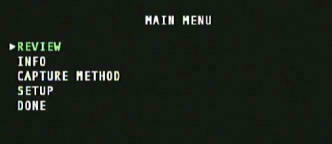
|
|
ADC Air System Menus The
button atop the ADC Air acts as a shutter release triggering image
capture when it is depressed. User control of the ADC Air is
accomplished through hierarchical system menus such as the one shown at
left. These are accessible through the system software (PixelWrench2)
running on a Windows computer connected to the camera via its USB
interface. The system menus present users with a series of
configuration choices. Scrolling through and selecting these
configures the camera. Check out the User Manual below for precise descriptions of the system menus and all other controls and connections in the ADC. |
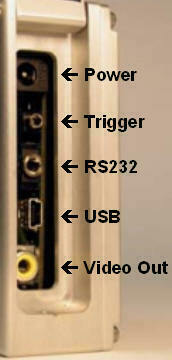 |
|
ADC Air Connections
Power:
The ADC Air obtains its power from a 12 VDC external power supply
provided with the unit. This plugs into the 12V power input below
a weather-sealed access cover on the side of the chassis.
Trigger:
An External Trigger Cable (un-terminated on one end) is available with
the system for remotely triggering the camera to capture images.
Closing the connection between the RING and the TIP on the provided
cable causes the camera to trigger (reference TYPICAL EXTERNAL TRIGGER CIRCUIT for further details). The ADC Air may also be triggered in a variety of other ways (see below).
RS232:
The camera contains an RS232 link that may be connected to a GPS
receiver for capturing the precise GPS coordinates at the exact instant
that an image is captured.
USB:
Below the RS232 connector, the USB connector provides a link to host
computers. PixelWrench2 can process images accessed via this
link. In manned aircraft, Tetracam's optional
SensorLink
GPS waypoint triggering application enables camera triggering at pre-defined waypoints via the USB interface.
Video
Out: The camera contains a Video Out connector that may be used to
output system menus, the camera's current view or captured images to a remote receiver via a wire or telemetry.
|
Multi-I/O
Connector: The ADC Air also contains a Multi-I/O connector on the
rear of the unit. This provides a link to an optional ADC/MCA
Controller Box. The ADC/MCA Controller Box enables ADC Air users
to remotely control the camera.
ADC/MCA
Controller Box -The optional ADC/MCA Controller Box (shown at right)
contains buttons that enable the user to manually scroll up and down
through system menus, pick a selection or take a picture. The box
also contains an RS232 connector and Video Out connector that are
linked to the camera through the Multi-I/O Connector. These links
simplify cabling when the ADC Air is used in a manned aircraft.
The ADC/MCA Box comes standard with a six foot (1.8288 m) Hirose cable
but longer cables are available upon request.
|
|
|
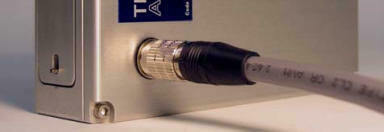
|
|
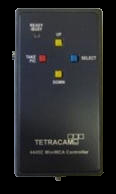
|
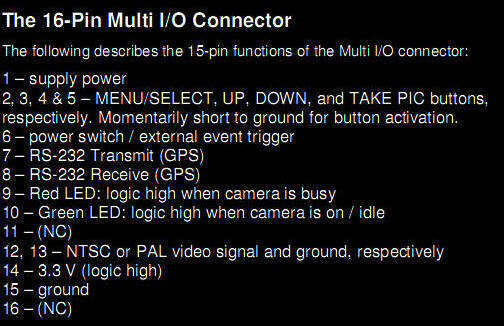
|
|
Information
on the ADC Air's Multi-IO Hirose circular connector and the cables
that may be connected to it are shown on our web site here. |
Standard System Contents
| |
System Contents Includes:
System Includes:
ADC Air Camera
2GB Certified CF card
8.0 mm "C" mount lens
Rugged Pelican Carrying Case
12 VDC external power supply
External power cable (un-terminated on one end)
External Trigger Cable (un-terminated on one end)
USB Cable
White Teflon Calibration Plate (AKA Calibration tag or
Software Calibration Tile)
System CD with PixelWrench2 software (PW2)
(See additional CD contents at right)
Typical Availability:
2 to 3 weeks (although faster turnaround times are often
possible). Please contact us for more information regarding
configuration options, pricing and availability.
Options Commonly Purchased with this Product:
|
|
List of files on included CD: 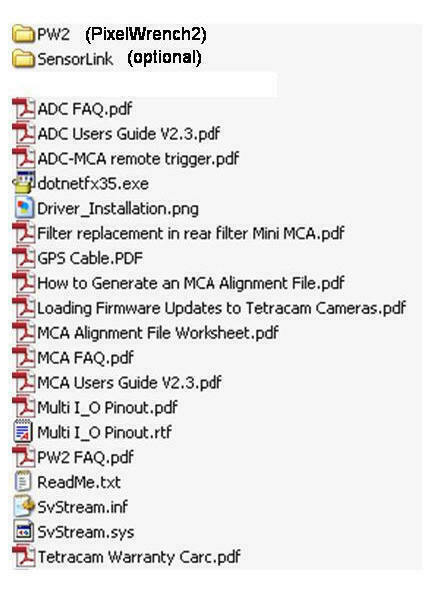
|
Features and
Specifications |
|
| |
 Features Features |
|
 Specifications Specifications |
|
| |
-
High resolution and precise spectral accuracy
- Simple operation and control
Weather-tight and fully protected for harsh environments
Recommended system for carrying aboard manned aircraft
- Red, Green and NIR bands (approximating
TM2, TM3 and TM4) provide the information needed
for
extraction of
NDVI, SAVI, canopy segmentation and
NIR / Green ratios.
- Video out in PAL or NTSC format
GPS-logging of captured images with external receiver
- User interchangeable optics
- The optional
SensorLink GPS waypoint triggering
application enables camera triggering at pre-defined
waypoints.
- Uses standard Compact Flash Memory cards (standard = 2 GB Optional = up to 256 GB)
-
Multiple Camera Triggering Methods
-
Shutter
Release: The button atop the ADC Air acts as a shutter release
for the camera. Depressing the button triggers the camera to take
a picture.
-
Auto-Timer: The ADC Air may be configured to capture images continuously at intervals
specified by the user via the camera's system menus.
Press the Shutter Release or trigger the camera via one of the methods
below to begin continuously capturing images. Press the Shutter
Release or trigger the camera again to stop continuous capture of images.
Always stop continuously capturing images by pressing the Shutter Release
or via a trigger command prior to powering the camera off.
Interruption of power during continuous capture of images may damage the
camera.
-
External Remote Trigger:
Closing
the connection between the RING and the TIP on the included External
Trigger Cable causes the camera to trigger (reference TYPICAL EXTERNAL TRIGGER CIRCUIT for further details).
-
Computer Triggering: The camera may be triggered through its USB interface. Optional GetShot software enables remote triggering
under command of a linked computer. Optional
SensorLink
GPS
waypoint triggering application enables camera triggering at
pre-defined waypoints - a popular method used in manned aircraft.
-
Remote
Shutter Release: The ADC Air's optional ADC/MCA Controller Box enables
users to manually trigger the camera by pushing a button at the desired
moment.
-
RS-232
Triggering: The camera may be commanded to trigger by receiving
an <ESC> T command via its RS232 serial interface on the ADC
Air's optional ADC/MCA Controller Box (see above).
Due to the delays incumbent in a serial link, the RS232 link is more
commonly used to transfer GPS position coordinates to the camera at
camera trigger time. When the camera is connected to a GPS receiver via
its RS232 link, the camera records the coordinates of the location at
which each image is captured into its log file upon receiving any
camera trigger command.
-
Powerful PixelWrench2 image editing
software with several tools specific to multi-spectral images and Tetracam cameras (see Tetracam Application Software Overview for further details) -
Superior Low Noise Image Sensor
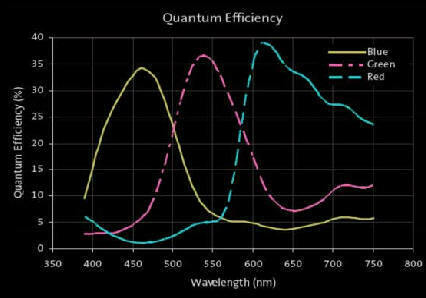 |
|
-
3.2 megapixel CMOS image sensor (2048 x 1536 pixels)
-
Green, Red and NIR sensitivity with bands approximately equal to
TM2, TM3 and TM4.
-
Image storage to Compact Flash in Tetracam 10 bit DCM lossless, 8 bit RAW, and 10 bit RAW formats.
-
Tough CNC machined aluminum housing.
-
Camera body CS lens mount
system with C mount adapter is compatible with thousands of available
lenses.
-
Camera supplied with a 8.0 mm lens
Optional 4.5 - 12 mm varifocal lens also available.
-
USB interface
-
Multi-pin I/O connector for use with Tetracam ADC/MCA Controller Box
-
Image Capture Capacity:
Up to
~3 MB per image (DCM format), limited only by CF card size.
-
Maximum Image
Capture Rate: Approximately 1.0 to 7.5 Seconds between
consecutive images depending upon image format and resolution selected - See
Interval
Tables
-
Power Consumption
Two watts nominal
-
Outputs:
Real time NTSC or PAL Video for both viewfinder and menu operations.
-
Data Interface:
USB 1.1
-
Environmental
- Note: the camera will operate outside of the recommended
environmental range, however performance may be degraded.
-
Temperature
0 degrees Celsius to 40 degrees Celsius (32 degrees Fahrenheit to 104
degrees Fahrenheit)
-
Humidity
Less than 85% relative humidity, non-condensing
-
Dimensions:
5.4 in. x 3.5 in. x 3.2 in. (137 mm x 90 mm x 80 mm) with lens hood in place (see link below to drawings)
-
Weight
22 oz. (630 gr.) without multi-I/O cable
-
Mount:
Two 1/4-20 UNC X .28 sockets on bottom of camera; .650" from back of camera and 1.325" from each side
|
|
| |
Additional ADC Air Reference
Information
Example ADC Air Multispectral Image |
|
| |
|
|
| |
 |
|
| |
Aerial Crop Photo taken with ADC Air |
|
|
|
|

|
|
|
